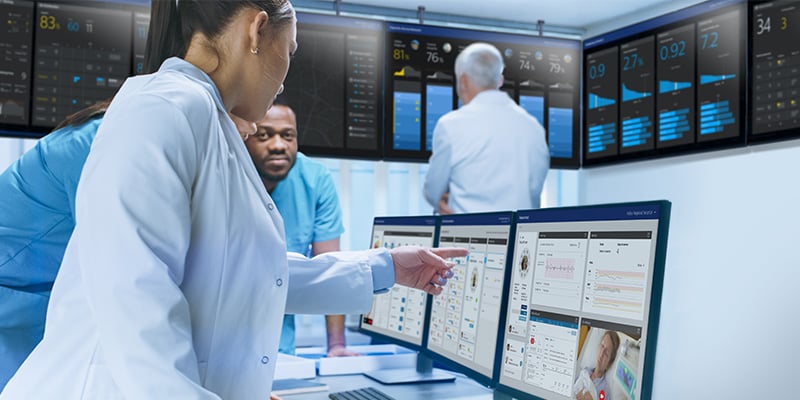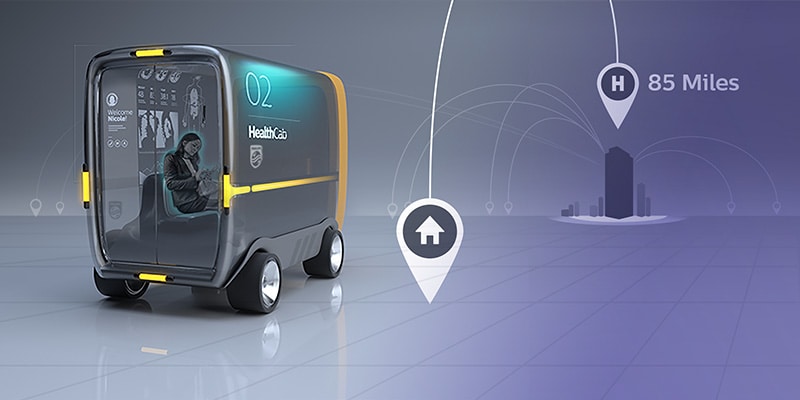Reimagining clinical and consumer healthcare environments
Mar 24, 2021 - Reading time 4-6 minutes
This article was created by Philips with Insider Studios, and was first published on Insider.
With seismic shifts and unprecedented strain in healthcare, models of care have been tested, broken, and hastily adapted to deal with uncertainty and unpredictability. For health system C-suite leaders, the process has revealed obstacles as well as opportunities for growth.

Now, we can see how healthcare ecosystems with digitally smart, interconnected hospitals can become healthcare information hubs for their broader communities. These ecosystems will connect care from hospital to home with engaging consumer experiences and device- and setting-agnostic service models.
Building a future-forward healthcare ecosystem
The COVID-19 global pandemic has shown us the importance of becoming better at scaling intensive care unit (ICU) and non-ICU space, testing and triage sites (and now vaccine sites), remote monitoring, and enabling seamless transitions of care across and outside the hospital.
In the near future, tele-ICUs within larger hospitals will be connected to mobile facilities and community-based hubs by a single digital infrastructure. Staff in these centralized care coordination centers will support patient flow and manage resources remotely to send clinicians and equipment to where they are needed most.
Future high-performing health systems will be designed to leverage data and new technologies to improve digital health and well-being and deliver better care through precision diagnosis, hospital-to-home virtual care, and telehealth.
Instead of being one fixed location, the hospital of the future is a decentralized but connected network of care sites and virtual care options. It's flexible enough to deliver highly complex care to large numbers of new patients in evolving locations, while continuing to provide routine and elective care to the rest of the population.
Increased care quality, access, and convenience
Care delivery will continue to be transformed globally. Mobile units could arrive on a patient's doorstep so that a healthcare worker can conduct an examination in person in the vehicle and receive advice remotely from a doctor via a video session. At Philips, we're testing this "hospital comes to you" concept with mobile units in the Japanese cities of Aomori and Ina, where there's a rapidly aging population and a shortage of medical facilities and healthcare staff.

Prototype mobile healthcare unit
In India, Philips worked with local partners to design and implement a mobile ICU solution. Masina Heart Institute uses this pre-fabricated transportable ICU solution as a separate Advanced Cardiac Care Unit to make heart procedures feasible while simultaneously providing care for COVID-19 patients.
Even without the challenges of a global pandemic, better access to healthcare is needed now more than ever. In the United States, Philips is working with the US Department of Veterans Affairs on the ATLAS (Advancing Telehealth Through Local Area Stations) program. The ATLAS Program makes healthcare more accessible for rural veterans so they don't have to travel long distances to a hospital.
Dynamic healthcare ecosystem from hospital to home
Care will also become more patient-centric and personalized. Remote digital health technology can foster a more holistic, longitudinal, and ultimately cost-effective approach in the lower-cost setting of the home. In a virtual care model, patients wearing biosensors can be continuously monitored at home, providing better control over the patient population and less pressure on acute care facilities.
For those who live with chronic diseases or who may have recently been discharged from hospital care, biometric sensors can continuously relay vital signs such as heart and respiratory rates back to algorithms that will notify care teams, in case of deterioration. This technology is available now, and hospitals can start to predict when patients might need medical attention, as well as where and when they will need extra beds, equipment, or staff. In this interconnected consumer-focused digital ecosystem, providers can also advance the behavioral aspects of health, making healthcare more proactive versus reactive for better health outcomes.
Co-creating the future of healthcare
There is a clear need to redesign care with an ecosystem approach spanning from hospital to home. To address these fundamental shifts, healthcare's C-suite executives are rethinking their business strategies to achieve economies of scale, transform disparate data into action, and drive frictionless experiences and wellness-based approaches to promote population health.
The best way to predict the future is to create it. We have the capabilities and knowledge to adapt and adopt new technologies that connect everyone to better care, anytime and anywhere. To achieve a mature ecosystem of care, healthcare C-suite executives need integrated solutions, improved workflow, flexible business models, and strategic partnerships to keep both their patients, staff, and their business — healthy.
As hospital leaders adapt to the changing healthcare landscape, they need partners who are proactive, responsive, and collaborative. Learn how we deliver innovative services that expand access to care, develop interoperable healthcare informatics platforms, and optimize clinical/operational workflows to improve patient care.
Disclaimer: Not all products or services are available in all geographic areas.
